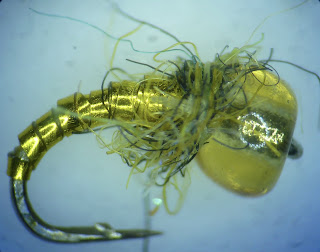After being stuck in the low thirties in my Manitoba species on the fly list for a couple of years I decided to shift gears this year and start thinking about catching micros. Fast forward to now, I’ve added 2 species, increased the number to 35 and am firmly hooked on the concept. I hadn’t expected the level of excitement nor the interesting challenges this niche of fishing can bring.
My initial searches found little that was helpful, most fishers who concentrated on micros used either worm bits or a flour based paste. I discovered one source, Tenkarabum.com to be extremely useful. Chris Stewart, the site owner, has written extensively about catching micros on flies although the information is somewhat scattered around his site. Trust me though, if you enjoy the idea of fishing for smaller fish you’ll enjoy your time on his site.
Chris writes about a number of different flies essential for the tenkara fisherman but for micros on a tenkara rod he uses a black killer bugger almost exclusively, mainly in a size #26. I haven’t been able to source a #26 but have found some #24s, so I’ll be tying up these.
For other flies I might use on my micro quest I went to my own well of experience. My several winters of fishing a tail water trout fishery in Texas where tiny midges prevailed resulted in a number of minnow catches. It’s those flies I’ll try up here in Manitoba, albeit a bit smaller. While the Texas midges were all tied on #20 and larger hooks, my fishing here will use midge pupa patterns tied on #20 down to #30 hooks. I wonder if pattern or colour is important. I’ll tie up a number of different patterns to experiment. The zebra midge pattern was one of my more effective patterns down south. Should the need arise I’ll tie up some midge larva patterns.
Although I haven’t had the opportunity to use dry flies on micros this year, I plan to have a few of those in my arsenal as well. Griffiths Gnat and a #22 ant pattern come to mind.
For a wet fly pattern very little can beat a North Woods Spider, hopefully I’ll be able to find feathers small enough on my starling cape.
Tying small flies can be challenging for beginning fly tiers but shouldn’t pose any problems for experienced tiers. I highly recommend anyone interested to give them a try.
The only tippet sizes I’ve used so far are 6X and 7X and I see little need to deviate from this.
While some experts promote the use of loop knots with these tiny flies, I’ve gone exclusively with a double Davy’s. A single Davy’s might be adequate for micros and I may experiment with that at some point. I have lost several very nice, larger fish on a single Davy’s knot.
I’ve tied most of my micro flies using 50D (8/0) G.S.P. thread. I’ve got some 30D (12/0) thread but find going that fine unnecessary.
It’s fall here in Manitoba and minnow numbers are close to their lowest numbers for the year so I’m not sure what the next few fishing excursions will bring. Only a few weeks ago I was catching common shiners regularly near home but a few cormorants on that body of water has changed that. The cormorants and minnows are now both gone.
Following are some pictures of smaller flies taken under a stereoscope.








